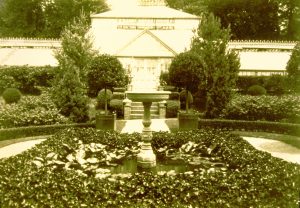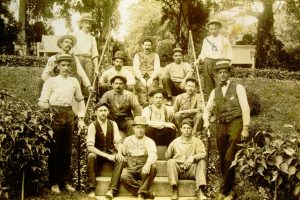For the past many weeks, I have been exploring the history of Evergreen’s gardens in preparation for the July 7th launch of Evergreen Exteriors, a three part virtual lecture series on the grounds and architecture of the museum’s 1858 home. Remarkably, this research took me on an extended journey that concludes with yet another story about unusual produce . . . .
The development of Evergreen’s landscape design was as integral to the aesthetics of the estate as the architecture of the house. Like the house itself, the grounds evolved to accommodate the changing tastes of its owners between the 1880s and 1930s. In 1905, Evergreen received special praise in the Baltimore Sun for its extensive gardens and grounds consisting of exotic plants and flowers, wooded areas, and expansive greenhouses. According to the Sun, Evergreen was surrounded by “64 acres of woodland” and “20,000 feet of glass” protecting “hothouses for orchids . . . that have blossomed with over 1,000 rare and curious flowers.” (Baltimore Sun, Oct 1, 1905, p. 8)
Evergreen’s archival photo collection contains many images of the elaborate complex of greenhouses at Evergreen. Construction on the greenhouses began in the early 1880s for Alice Whitridge Garrett (1851-1920) who was keenly involved in Evergreen’s landscape design during her forty year residency there.

We currently do not know very much about the people who actually cultivated the gardens for Alice and other members of the Garrett family at Evergreen. However, we have learned that among Evergreen gardeners was a man named Charles Uffler who lived for a time at the estate and whose horticultural skills earned him extensive recognition and prizes. In February 1905, Uffler won first prize at an annual Baltimore gardening exhibit for his “100 blooms of Enchantress” grown in the Evergreen conservatories along with some notable French hot-house tomatoes. (Baltimore Sun, Feb. 25, 1905, p. 12)

Clearly, Uffler had a knack for cultivating fruit. Years after his employment at Evergreen, he achieved the newsworthy feat of growing a cantaloupe in a jar! Although the melon-in-a-jar was not an Evergreen product, it seems worth mentioning all the same. It was cultivated in 1912 in a carafe at the county home of Mr. William H. Grafflin of Glencoe, Maryland. Placed inside the bottle as a wee, little melon, the gourd eventually grew to full-size inside its glass chamber. (Baltimore Sun, Sept. 24, 1912, p. 7) How’s that for a resume-booster?
